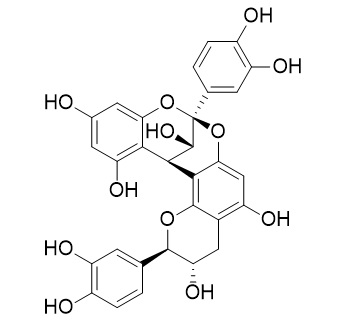Procyanidin A1
Procyanidin A1 has antiallergic effects, it inhibits degranulation downstream of protein kinase C activation or Ca2⁺ influx from an internal store in RBL-2H3 cells. Procyanidin A1 shows a very high inhibition effect on LDL oxidation, with the IC50 value of 0.94 uM.
Inquire / Order:
manager@chemfaces.com
Technical Inquiries:
service@chemfaces.com
Tel:
+86-27-84237783
Fax:
+86-27-84254680
Address:
1 Building, No. 83, CheCheng Rd., Wuhan Economic and Technological Development Zone, Wuhan, Hubei 430056, PRC
Providing storage is as stated on the product vial and the vial is kept tightly sealed, the product can be stored for up to
24 months(2-8C).
Wherever possible, you should prepare and use solutions on the same day. However, if you need to make up stock solutions in advance, we recommend that you store the solution as aliquots in tightly sealed vials at -20C. Generally, these will be useable for up to two weeks. Before use, and prior to opening the vial we recommend that you allow your product to equilibrate to room temperature for at least 1 hour.
Need more advice on solubility, usage and handling? Please email to: service@chemfaces.com
The packaging of the product may have turned upside down during transportation, resulting in the natural compounds adhering to the neck or cap of the vial. take the vial out of its packaging and gently shake to let the compounds fall to the bottom of the vial. for liquid products, centrifuge at 200-500 RPM to gather the liquid at the bottom of the vial. try to avoid loss or contamination during handling.
Life Sci.2021, 286:120019.
The Journal of Internal Korean Medicine2015, 36(4):486-497
Sci Rep.2017, 7(1):3249
Prev Nutr Food Sci.2025, 30(1):92-100.
Food Chem X.2024, 21:101208.
Hindawi J of Food Biochemistry2023, P17:8883860
FASEB J.2022, 36(7):e22387.
Biomol Ther (Seoul).2024, 32(5):546-555.
Food Chem.2024, 456:140044.
J Biochem Mol Toxicol.2020, 34(7):e22489.
Related and Featured Products
Biosci Biotechnol Biochem. 2011;75(9):1644-8.
Effects of peanut-skin procyanidin A1 on degranulation of RBL-2H3 cells.[Pubmed:
21897038]
Peanut skin contains large amounts of polyphenols having antiallergic effects.
METHODS AND RESULTS:
We found that a peanut-skin extract (PSE) inhibits the degranulation induced by antigen stimulation of rat basophilic leukemia (RBL-2H3) cells. A low-molecular-weight fraction from PSE, PSEL, also had inhibitory activity against allergic degranulation. A main polyphenol in PSEL was purified by gel chromatography and fractionated by YMC-gel ODS-AQ 120S50 column. Electrospray ionization mass spectrometry (ESI-MS) analysis of the purified polyphenol gave m/z 599 [M+Na]⁺. Based on the results of ¹H-NMR, ¹³C-NMR spectra, and optical rotation analysis, the polyphenol was identified as Procyanidin A1. It inhibited the degranulation caused by antigen stimulation at the IC₅₀ of 20.3 µM. Phorbol-12-myristate-13-acetate (PMA) and 2,5,-di(tert-butyl)-1,4-hydroquinone (DTBHQ)-induced processes of degranulation were also inhibited by Procyanidin A1.
CONCLUSIONS:
These results indicate that peanut-skin Procyanidin A1 inhibits degranulation downstream of protein kinase C activation or Ca²⁺ influx from an internal store in RBL-2H3 cells.
Int J Mol Sci. 2017 Jun 26;18(7).
5-(3',4'-Dihydroxyphenyl-γ-valerolactone), a Major Microbial Metabolite of Proanthocyanidin, Attenuates THP-1 Monocyte-Endothelial Adhesion.[Pubmed:
28672844 ]
Several metabolomics of polymeric flavan-3-ols have reported that proanthocyanidins are extensively metabolized by gut microbiota. 5-(3',4'-dihydroxyphenyl)-γ-valerolactone (DHPV) has been reported to be the major microbial metabolite of proanthocyanidins.
METHODS AND RESULTS:
We demonstrated that DHPV has stronger prevention effect on tumor necrosis factor (TNF)-α-stimulated adhesion of THP-1 human monocytic cells to human umbilical vein endothelial cells compared to its potential precursors such as Procyanidin A1, A2, B1 and B2, (+)catechin, (-)epicatechin and its microbial metabolites such as 3-(3,4-dihydroxyphenyl)propionic acid and 2-(3,4-dihydroxyphenyl)acetic acid. Mechanism study showed that DHPV prevents THP-1 monocyte-endothelial cell adhesion by downregulating TNF-α-stimulated expressions of the two biomarkers of atherosclerosis such as vascular cell adhesion molecule-1 and monocyte chemotactic protein-1, activation of nuclear factor kappa B transcription and phosphorylation of I kappa-B kinase and IκBα.
CONCLUSIONS:
We suggested that DHPV has higher potentiality in prevention of atherosclerosis among the proanthocyanidin metabolites.
Food Science & Technology Research, 2015, 21(1):111-5.
Inhibitory Effect of Oligomeric Polyphenols from Peanut-skin on Sugar Digestion Enzymes and Glucose Transport[Reference:
WebLink]
METHODS AND RESULTS:
Inhibitory effects of oligomeric polyphenols extracted from peanut skin on α-amylase, maltase, sucrase and glucose transport were investigated. Epicatechin-(4β→6)-epicatechin-(2β→O→7, 4β→8)-catechin (EEC) as a procyanidin trimer inhibited α-amylase activity in a dose-dependent manner, while (+)-catechin and Procyanidin A1 as a procyanidin dimer did not show any inhibitory activity up to 5 mg/mL. In the case of sucrase, EEC showed inhibitory activity stronger than (+)-catechin and Procyanidin A1. Inhibitory effects of peanut skin on glucose transport in the small intestine were also investigated. The level of glucose transport in Caco-2 cells was significantly decreased by EEC compared to (+)-catechin.
CONCLUSIONS:
These results suggest that the inhibitory effects of procyanidins on α-amylase and α-glucosidase, and the suppression of intestinal glucose transport may change with the degree of polymerization.
Arch Pharm Res. 2014 Nov;37(11):1403-10.
Procyanidins from the stem wood of Machilus japonica and their inhibitory effect on LDL oxidation.[Pubmed:
24297667 ]
The stem wood of Machilus japonica Siebold & Zucc were extracted with 80 % aqueous MeOH, and the concentrated extract was successively partitioned with ethyl acetate (EtOAc), normal butanol, and water.
METHODS AND RESULTS:
From the EtOAc fraction, five procyanidins, Procyanidin A1 (1), procyanidin A2 (2), procyanidin B7 (3), cinnamtannin B1 (4), and aesculitannin B (5), were isolated. Their chemical structures were identified through spectroscopic data analyses including NMR, MS, and IR. This is the first time any of these compounds have been isolated from this plant.
CONCLUSIONS:
The compounds were evaluated for inhibition activity on LDL oxidation.
All of these compounds and the positive control, BHT, showed a very high inhibition effect with IC50 values of 0.94, 2.1, 1.8, 1.1, 1.0, and 1.9 μM, respectively.



